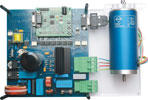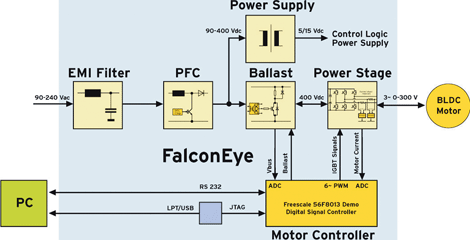
Electronic motor controls for brushless motors offer developers enormous potential as electronically commutated brushless motors open up new areas of possibilities, which include significant energy savings, high-precision control options and considerable improvements in EMI behaviour. However, considerable expertise is required for the implementation of this potential and this may take up limited development resources.
Reference platform
In order to shorten the time-to-market when employing digital motor control for brushless motors, as well as to make the developer's job easier, EBV Elektronik in conjunction with franchise partners Avago Technologies, Fairchild Semiconductor, Freescale Semiconductor and STMicroelectronics, has developed the FalconEye reference platform. This product incorporates the Freescale 56F8013 16-bit signal controller with integrated DSP functionality as the central control element and includes the entire range of electronics for controlling a brushless motor.

Developers can use FalconEye during their development work and, if necessary, also receive design documentation in order to integrate the board directly into their design. The wiring diagram and software demonstration projects are also delivered with the board, as is a 300 V brushless direct current (BLDC) motor produced by dematek, which is already equipped with a second shaft extension for an incremental encoder from Avago. FalconEye can also be incorporated into an application as a complete board - a procedure which, although not necessarily part of the basic concept, is quite common in prototypes, for example.

The version of FalconEye currently available has been designed for operation at standard supply voltages. However, modification of the power stage also allows the reference board to be used for other motor voltages. At present, FalconEye is optimally suited to controlling BLDCs. However, the board can also be converted to control brushless alternating current motors, switched reluctance motors and induction motors.
Flexible control
Due to the high complexity involved in controlling brushless motors, EBV uses a board-on-board design (piggyback) for the central computing unit of FalconEye. In the version now available, the 56F8013 demonstration board from Freescale controls the motor. This 56F8013 board is attached directly onto the FalconEye motherboard with the power electronics. By exchanging this control board, other control elements can also be used as microcontrollers with the FalconEye board. With this modular approach, FalconEye is deployable in a number of applications and work is under way on further control solutions for the board.
The current version of the board uses a digital signal controller from Freescale in conjunction with analog components for electrically isolated current measurement from Avago. The BLDC motor is driven with the FSBB15CH60 smart power module from Fairchild.
The 56F8013 digital signal controller allows hall sensors to be used as feedback elements in FalconEye. The feedback branch is regulated via a standard microcontroller I/O on the controller. By adding only a few components, the 56F8013 also allows precise encoders to be connected.
The 56F8013 board used in FalconEye is suitable for demonstration purposes as well as for the development of applications. Via an RS232 interface, LEDs that the user can program, and a few buttons, it is already possible to cover a number of I/O functions. The host computer is connected via the RS232 interface while a JTAG pod connects the JTAG port to the parallel interface of a PC during software development.
Flexible tools
Using the tool suite for the 56F8013, developers are able to develop and simulate routines, load software into the Flash memory of the DSP microcontroller and to run this software. The debugging is then carried out via the JTAG/EOnCE port. The developer can also define complex breakpoint conditions, which are taken into account at full runtime speed. Moreover, the tools allow all registers, memories and peripherals to which the user has access to be examined and/or modified via the EOnCE port. The galvanic isolation means that the development engineer can test his algorithms safely, even if the target application does not include galvanic isolation due to cost reasons.
The board in detail
Besides the control electronics, optimum semiconductor components have been selected for each motor control board.
The BLDC motor is controlled by the UL-certified FSBB15CH60 smart power module from Fairchild. This is a complete three-phase IGBT inverter in which the gate control and the protective circuit are already integrated. With its special connections for the direct current intermediate circuit, the smart power module allows each of the three-phase currents to be monitored individually. Optionally, the FSAU15CH60 smart power module in a single inline package can be used. This semiconductor module, specified with 600 V/15 A is designed for an effective insulation voltage of 2500 V and makes it possible to directly connect brushless motors which work with a DC link voltage between 300 and 400 V, which result from the rectification of the 220 V system voltage. Today, PFC (power factor correction) is usually also required. By using an active circuit to correct the power factor, the DC link voltage increases to a value between 380 and 400 V.
In the case of FalconEye, the active correction of the power factor is performed with an NCP1653 PFC chip from On Semiconductor. This CCM-PFC circuit (CCM: continuous conduction mode) works according to the follower boost or continuous voltage principle with fixed switching rates of 67 or 100 kHz. Under-voltage and over-voltage protection, programmable over-current protection and a programmable overload limit, as well as automatic deactivation with hysteresis in the case of thermal overload, have already been integrated in the NCP1653.
As a 600 V circuit breaker for the PFC, EBV uses the STW30NM60 from STMicroelectronics, which has an RDS(on) of less than 0,145 O at 30 A load capability. This MOSFET, type STW30NM60D, already contains a quick diode with short block recovery time. The PFC diode is the STTH3006D from STMicroelectronics, which has a block recovery time of 400 ns and is also specified for 600 V/30 A. However, the board also contains an efficient switchmode power supply in which the FSQ321 from Fairchild provides the supply voltage for the logic: from 300 V input voltage, galvanically isolated 15 V are generated at the output. Diodes from STMicroelectronics are used for the bootstrap circuit. As a result, a separate gate voltage supply is unnecessary as the 15 V supply already available, is sufficient for this purpose.
Safety first
The galvanic isolation of the gate signals between the control electronics of the power electronics connected to the system voltage is provided by six ACPL-4800 type optocouplers from Avago - one optocoupler per IGBT of the inverter. This means that the necessary safety is already ensured during the development phase. Galvanic isolation of the I/Os from the load side is carried out by the HCPL-050L digital optocouplers from Avago, which transmits the data at a maximum rate of 1,5 Mbps. It is possible to measure the motor current of the three phases in an isolated circuit via two HCPL-788J insulation amplifiers from Avago, which are equipped with integrated short-circuit and overload detection.
Brake control
In addition to controller, current measurement and power stage with PFC, FalconEye also contains a small brake control with which the kinetic energy of a motor, which can no longer be stored in the dc-link capacitor, is converted into heat. A Fairchild IGBT (SGH 15N60) with the ACPL-3130 gated driver from Avago and a brake resistance ensure that the DC-link voltage cannot exceed permissible limits. In practice, this means that FalconEye also enables dynamic braking - a feature that is necessary in positioning drives that must remain in a particular position. At present, energy feedback in the low power range is not the norm, so that the energy stored in the DC-link capacity is generally converted into heat via the integrated ballast circuit.
While FalconEye may only have one power stage, it is nevertheless often necessary in more complex systems to control a number of motors, with the result that a motor can use the brake energy of another motor for its drive. This is because although each of the motors has its own control, they can still use a common DC-link circuit. In this case, the brake resistance acts primarily to protect the intermediate circuit against over-voltage if, for example, all motors stop simultaneously in the case of emergency shutdown (emergency stop).
Applications
There is a wide range of applications for FalconEye. For example, the use of regulated permanent magnet motors in ventilators and pumps instead of asynchronous motors, results in a considerable improvement in the effective range. The relevant applications include white goods, medical systems and the industrial market including robot controls.
To learn more about the FalconEye platform, visit www.ebv.com/falconeye
| Tel: | +27 11 236 1900 |
| Email: | [email protected] |
| www: | www.ebv.com |
| Articles: | More information and articles about EBV Electrolink |

© Technews Publishing (Pty) Ltd | All Rights Reserved